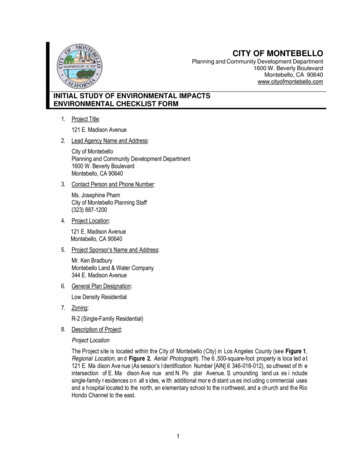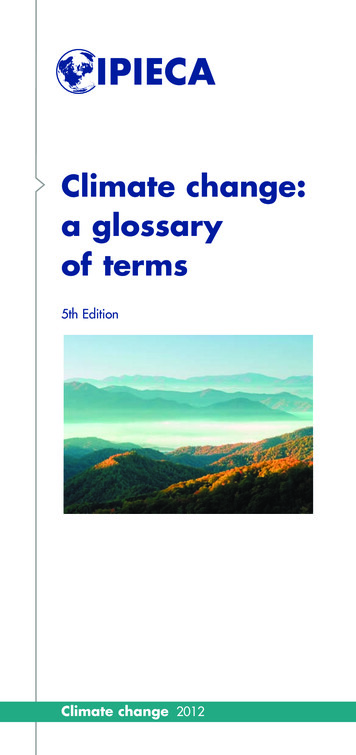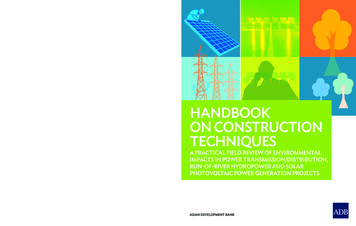
Transcription
Activities, EnvironmentalImpacts & Aspects
Iowa EMS Framework (HF 2570)EnvironmentalPolicy StatementEnvironmental Aspects &ImpactsObjectives & Targets6 Plan Components Yard Waste Management Hazardous HouseholdWaste Collection Water QualityImprovementLegal & OtherRequirementsPLANNINGAction PlanIdentify Roles &ResponsibilitiesCommunication,Training & Awareness Greenhouse GasReduction Recycling ServicesMonitoring &Measurement Environmental EducationAssessmentReevaluation andModificationIMPLEMENTATIONAND OPERATIONCHECKING AND ACT
To ReduceEnvironmental ImpactsIs the Main Purpose of an EMS
CAUTION: This is the MostConfusing and Difficult Part of theEMSRecommended Site Visits in Assist in January
HF 2570 EssentialsEnvironmental Impacts:The organization identifies and evaluates theactual or potential aspects and impacts to theenvironment, whether adverse or beneficial,from its activities, services and facilities. Duringthe evaluation process, significant impacts to theenvironment are determined.
Definitions Activity A Task or OperationGenerally Occurring Within theEMS Fenceline Fueling/Operating VehiclesPurchase of ChemicalsEnvironmental Education Aspect The Activity’s Interaction with theEnvironment Air EmissionsNatural ResourcesRecycling
Definitions Impact Negative A Change to the Environment, Positive orDegradation of Air QualityDecrease in Natural ResourcesIncrease in Landfill Space Significant Impacts Those EnvironmentalImpacts that the Organization Places the HighestPriority
EMS Terminology– “Aspects”“Aspects are elements of an organization’s activitiesor products or services that can interact with theenvironment.” Generally a Difficult Concept and ConfusionBetween Aspects and Impacts
Keep a Simple Aspect/ImpactAnalysis in Your Head Activity Changing Oil Aspects (Interaction) Air EmissionsUse of Oil, AbsorbentsRecycling of OilSpills Impacts (Result) Degrade Air QualityConsumption of Natural ResourcesIncrease Landfill SpaceDegrade Water Quality
Methods for IdentifyingAspects/Impacts Activities ListAlready Exists Evaluate Job Descriptions Evaluate Organization’s Budget Input and Output Method Interview Staff in Shop and Field EMS Core Team Meeting
Level of Detail in Activities Identification TooLittle Detail During Activities IdentificationMay Cause Significant Impacts to Be Missed Use Common Terminology for Shared ActivitiesBetween Facilities Vehicle Fueling Vs. Fueling Vs. Fuel Island Use TooMuch Detail Will Slow the Activities/ImpactsIdentification Process If you Get to 1,000, STOP!
Level of Detail in Activities Identification Input andOutput MethodComposting FacilityProcess: Yard Waste CompostingInputs:Yard WasteActivities:CompostingToo BroadOutputs:FinishedCompost
Level of Detail in Activities IdentificationRecycling FacilityProcess: Break Room Waste GenerationInputs:Cardboard KleenexPaper towelsPaper platesPlastic traysPlastic wrapPlastic utensilsAluminum cansPlastic bottlesGlass bottlesCoffeeCoffee filtersDish soapHand soapActivities:Opening food boxesUsing KleenexUsing paper towelsUsing paper platesUsing plastic traysUnwrapping plastic wrapUsing plastic utensilsOpening aluminum cansOpening plastic bottlesOpening glass bottlesBrewing coffeeWashing dishesWashing handsToo Much DetailOutputs:Empty cardboardcontainersUsed KleenexUsed paper towelsUsed paper platesUsed plastic traysUsed plastic wrapUsed plastic utensilsEmpty aluminum cansEmpty Plastic bottlesEmpty glass bottlesCoffee groundsUsed coffee filtersEmpty dish soapcontainersEmpty hand soapcontainers
Level of Detail in Activities IdentificationLandfill FacilityProcess: Disposal of WasteInputs:GarbageDiesel FuelEquipmentElectricityStormwaterLaboratory SuppliesMaintenance SuppliesAdmin. SuppliesActivities:Heavy Equipment OperationEquipment MaintenancePetroleum Product StorageMaterial StorageUse of ElectricityWater Quality MonitoringAdmin. SupportBuilding MaintenanceAdequate DetailOutputs:Waste DisposalAir EmissionsBiogasPotential SpillsLeachateSolid WasteNatural ResourceConsumption
Environmental Aspects/Impacts Use process toimpacts. identify activities, aspects andFirst, Identify Activities Within the Fenceline thatCould Have an Environmental ImpactThen, Identify How These Activities SpecificallyInteract with the EnvironmentLast, Document the Resulting Change, Positive orNegative (Impacts) EachActivity May Have Multiple Aspects andImpacts Intelex Also Allows Further Segregation ofNormal, Abnormal, and Emergency Conditions
Example
Example
Example Aspects/Impacts ListAspectImpactAir EmissionsDegradation Air QualitySpillsDegradation Air, Water, and SoilQualityWater DischargesDegrade Water QualityNatural ResourcesConsumption of Natural ResourcesRecyclingIncrease Landfill SpaceWaste GenerationDecrease Landfill SpaceHabitatHabitat Conservation
Best Practices for Aspects/ImpactsIdentificationWill be Assigned At Least OneAspects and Resulting Impact Common Terminology Will Assist in AssigningImpacts and Will Reduce Documentation Burden Engage Staff to Assist in Developing List Use Site Visit in January to Assist Every Activity
Two Case Studies: Identifying EnvironmentalActivities, Impacts & AspectsRathbun Area SolidWaste CommissionDuring a site visit, GS&Pworked with staff todevelop a list ofactivities, aspects andimpactsWaste Commission ofScott CountyThrough a series ofinternal meetings, theEMS Core Teamidentified activities,aspects and impacts
Activities and Impacts ExerciseEach Team Generate a List of Activities and ImpactsFrom the Assigned Example. Example #1 Example #3Landfill Transfer Station/Baling Maintenance Shop Composting Facility Example #2 Recyclables CollectionHHM SortingRecyclables SortingE-WasteDemanufacturingOffice Work Ticketing Shack Educational Workshop Stormwater Example #4Landfill Storm Water Runoff Compliance Sampling Fueling Island
Example #1
Example #2
Example #3
Example #4
Activities and Impacts ExerciseReport Out and Discussion
Significant Impacts
Significant Impacts Due toLimited Budgets and Staff, EMS allows forthe Prioritization of Environmental Impacts Determine Significant Impacts by Ranking EachEnvironmental Impact Against SignificanceCriteria
What are Significance Criteria? Criteria Used Byan Organization to IdentifyEnvironmental Impacts Having the Potential toSignificantly Impact the Environment Facilitate Prioritization of Environmental Impacts to BeAddressed Through the EMS
Significance Criteria Considerations Address Facetsof the Environmental Impacts Be Consistent With What is Important to theOrganization’s Priorities Alignment With EMS Policy Limit the Number of CriteriaNo Less Than 3, No More Than Six Avoid CriteriaWith Substantial Overlap Finally, Screen for the Six Plan Components They Should Be on the Significant Impact List
Example Criteria and Definitions Regulated - (legal requirement) Community/Media Concerns –(community concerns or perception) Impactto Human Health - (the potential Impactto Environment - (the potential oror actual impact to human health)actual impact to flora/faunaand/or other natural resources)
Example Criteria and Definitions Magnitude - (volume, size,or amount of the Impact) Severity - (measure of theintensity of the Impact;impact, damage, or deterioration) Probability - (measure of how likelyit is that the Impactwill occur)
Example Criteria and Definitions Cost - (the total money, time, and resourcesassociated with controlling, mitigating orresponding to an impact) Operational impact - (the level ofinfluence, consequence, or effect an Impact canhave on the day-to-day operations of theorganization) IsIt a HF Consideration
Scoring System The Simpler, the BetterCalculus is Not Going to Give you a Better Answer! ScoringSystem Can be Numerical or Descriptive 1 to 5 or 1 to 10 Low, Medium, HighLOWMEDHIGH
Scoring System (cont.) Document Scoring“Rules” to Provide forConsistency in the Process Activities/Impacts Willbe Revisited on a RegularBasis, So Get Something on Paper to Start Workingon and Then Move on!!
Scoring System Example Assigned criteria values:Low/Not Applicable 1; Moderate 3; High 5 Equation:(Criterion 1) (Criterion 2) (Criterion 3) (Criterion 4)x (Criterion 5) Total HFTotalScoreDegrade WaterQuality fromSpills5531570RecyclingOffice Paper1211525
Methods for Establishing a SignificanceThreshold Sort from High to LowLook for “Natural Break Point” Where Scores ChangeChoose a Threshold Value Set aLimit at What Your Organization Can Handle
Case Study Follow-Up : Rathbun& Scott County SignificanceCriteria
Rathbun Example
Scott County Example
Scott County Criteria Explained
List of Significant Impacts (Cedar Rapids)
Significant Impacts and Objectivesand Targets All SignificantEMS Impacts Must Be Addressed in thePrimarily Through the Adoption of an Objective andTargetObjectives and Targets Set, or Explain Why NotDon’t Take On Too Many Impacts at One Time Conduct aReality Check–Does It Makes Sense?
Significant Impacts Considerations Six Plan Components Must be Addressed(Yard Waste Mgmt, HHHW Collection, Water QualityImprovement, GHG Reduction, Recycling Services,Environmental Education) Make Surethe Six Areas are Included in SignificantImpacts List Other High Profile Issues E-Waste, Odors, etc. To Increase FocusOrganization on a Designated Area of theVehicle Fleet, Operational Efficiency, etc.
EMS Procedure Document YourProcess in Determining Activities,Impacts, and Significance Someone Will Have to Update This in the Future andIt May Not Be You! Include Responsibilities andFrequency ofUpdating Activities, Impacts, and Significance Usually on an Annual Basis Consider “Management ofChange” How are YouGoing to Review and Incorporate Changes inActivities Keep in Mind Impacts and Significant Impacts MayChange Through Time
Best Practices EngageStaff Across the Organization to DevelopActivities List Employ the Core Team to Identify SignificantImpacts Make Your Scoring Methods and Criteria Simple,but Meaningful Determine Significance Based on Scoring as wellas Organizational Priorities and Limitations Make Sure to Address 6 Plan Components Document Your Methods and Final Decisions Review Your List on a Periodic Basis (Annually)
Questions
Use process to identify activities, aspects and impacts. First, Identify Activities Within the Fenceline that Could Have an Environmental Impact Then, Identify How These Activities Specifically Interact with the Environment Last, Document the Resulting Change, Positive or Negative (Impacts) Each Activity May Have Multiple Aspects and .










